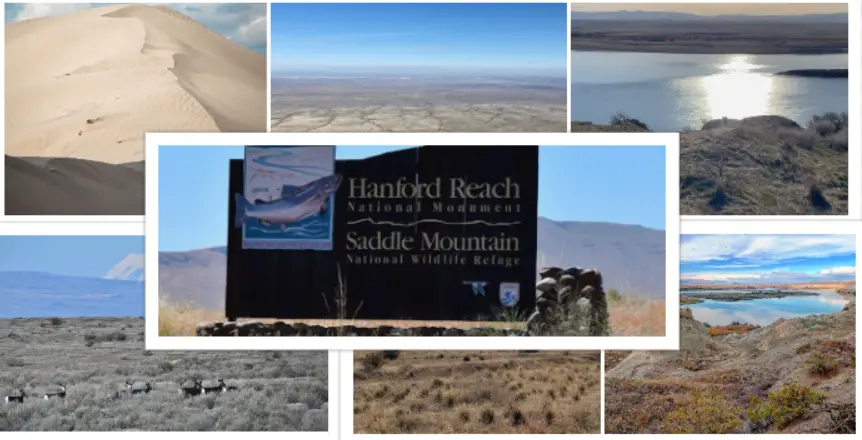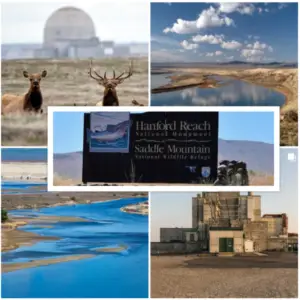Hanford Reach National Monument : Interesting Facts, History & Travel Guide

- By
- Aparna Patel
- |
- 1 Apr, 2023
- |

Welcome to our travel guide for Hanford Reach National Monument, a beautiful and unique protected area located in Washington state, USA.
In this guide, we’ll take you through the history and significance of the monument, as well as some interesting facts and travel tips for planning your visit.
Whether you’re interested in outdoor recreation, nature, or history, Hanford Reach National Monument has something to offer for everyone. So sit back, relax, and let’s explore this hidden gem together.
Table of Contents
Interesting facts about Hanford Reach National Monument
- It is one of the most pristine areas of the Columbia River. Hanford Reach National Monument is home to the last free-flowing section of the Columbia River in the United States. The river runs through the heart of the monument and provides habitat for a diverse array of fish and wildlife.
- It has a rich cultural history. The monument is home to several sites that are sacred to local Native American tribes, including fishing and hunting grounds, burial sites, and petroglyphs. The area was also used by early explorers and settlers.
- It is home to a variety of wildlife. The monument is home to more than 40 species of fish, including salmon, sturgeon, and lamprey. It is also an important habitat for several species of birds, including bald eagles, ospreys, and sandhill cranes.
- It is a popular recreation destination. Visitors to the monument can enjoy a variety of recreational activities, including fishing, hunting, hiking, boating, and wildlife watching. The area is also popular for camping and picnicking.
- It was established relatively recently. Hanford Reach National Monument was established by President Bill Clinton in 2000, making it one of the youngest national monuments in the country.
- It is home to a significant cultural resource. The monument includes the historic Hanford Site, which was used during World War II to produce plutonium for the Manhattan Project. The site is now managed by the Department of Energy and is closed to the public.
- It is an important conservation area. The monument was established to protect the unique natural and cultural resources of the Hanford Reach area. The protection of these resources is important not only for their intrinsic value, but also for the ecological health of the entire Columbia River ecosystem.
Read More:
- Hagerman Fossil Beds National Monument : Interesting Facts, History & Travel Guide
- Grand Staircase–Escalante National Monument : Interesting Facts, History & Travel Guide
- Grand Portage National Monument : Interesting Facts, History & Travel Guide
- Grand Canyon–Parashant National Monument : Interesting Facts, History & Travel Guide
- Governors Island National Monument : Interesting Facts, History & Travel Guide
Information & History of Hanford Reach National Monument
The area that is now the monument has a rich cultural history, with evidence of human habitation dating back more than 10,000 years. Native American tribes, including the Yakama, Umatilla, and Wanapum, have lived in the area for thousands of years and have a deep cultural connection to the land.
In the 1940s, the Hanford Site, located within the boundaries of the monument, was used to produce plutonium for the Manhattan Project. This top-secret operation was part of the United States’ effort to develop an atomic bomb during World War II. Today, the site is managed by the Department of Energy and is closed to the public.
The monument is home to the last remaining free-flowing stretch of the Columbia River in the United States. The river provides habitat for a wide variety of fish and wildlife, including salmon, sturgeon, lamprey, bald eagles, ospreys, and sandhill cranes. The area is also an important stopover for migrating birds on the Pacific Flyway.
In addition to its cultural and natural resources, the monument is also an important recreational destination. Visitors can enjoy a variety of activities, including fishing, hunting, hiking, wildlife watching, camping, and picnicking. The monument is also home to the Hanford Reach Interpretive Center, which provides visitors with information about the area’s natural and cultural history.
Hanford Reach National Monument is an important conservation area that protects the unique resources of the Hanford Reach area. The protection of these resources is critical not only for their intrinsic value but also for the ecological health of the entire Columbia River ecosystem.
Travel Guide for Hanford Reach National Monument
- Best time to visit: The monument is open year-round, but the best time to visit is in the spring and fall when temperatures are mild and wildlife is abundant.
- Getting there: The nearest airport is the Tri-Cities Airport in Pasco, Washington, which is about an hour’s drive from the monument. There is no public transportation to the monument, so you will need to rent a car or arrange for private transportation.
- Visitor center: The Hanford Reach Interpretive Center is the best place to start your visit. Here you’ll find information about the monument’s natural and cultural history, as well as maps and guides for hiking and other activities.
- Recreation: The monument offers a variety of recreational opportunities, including fishing, hunting, hiking, wildlife watching, camping, and picnicking. The Columbia River is a popular spot for fishing, and the monument offers several hiking trails that provide stunning views of the river and surrounding landscape.
- Wildlife: The monument is home to a wide variety of wildlife, including salmon, sturgeon, lamprey, bald eagles, ospreys, and sandhill cranes. Visitors should be respectful of wildlife and observe from a distance.
- Lodging and dining: There are no lodges or restaurants within the monument, but there are several options in nearby towns, such as Richland and Kennewick. Camping is available within the monument at the Columbia River Recreation Area.
- Safety: The monument is a remote area, and visitors should be prepared for changing weather conditions and limited cell phone service. It’s important to bring plenty of water, food, and appropriate clothing for the season.
Hanford Reach National Monument is a unique and beautiful area that offers something for everyone. Whether you’re interested in history, nature, or outdoor recreation, the monument is definitely worth a visit.
More Articles:
- Gold Butte National Monument : Interesting Facts, History & Travel Guide
- Gila Cliff Dwellings National Monument : Interesting Facts, History & Travel Guide
- Giant Sequoia National Monument : Interesting Facts, History & Travel Guide
- George Washington Carver National Monument : Interesting Facts, History & Travel Guide
FAQ about Hanford Reach National Monument
What is the significance of Hanford Reach National Monument?
The monument protects the last free-flowing stretch of the Columbia River in the United States, as well as a variety of wildlife and cultural resources. The area was also used for top-secret plutonium production during World War II.
What can visitors do at Hanford Reach National Monument?
Visitors can enjoy a variety of recreational activities, including fishing, hunting, hiking, wildlife watching, camping, and picnicking. The monument is also home to the Hanford Reach Interpretive Center, which provides information about the area’s natural and cultural history.
Is there lodging available at Hanford Reach National Monument?
There are no lodges within the monument, but camping is available at the Columbia River Recreation Area. There are also several lodging options in nearby towns.
What is the best time to visit Hanford Reach National Monument?
The best time to visit is in the spring and fall when temperatures are mild and wildlife is abundant.
Is Hanford Reach National Monument accessible to people with disabilities?
The monument has several accessible facilities and programs, including an accessible trail at the Columbia River Recreation Area and an accessible fishing dock.
Can visitors bring pets to Hanford Reach National Monument?
Pets are allowed in some areas of the monument, but they must be kept on a leash and under control at all times. Pets are not allowed in the Columbia River or on designated swimming beaches.
Are there any fees to enter Hanford Reach National Monument?
There are no entrance fees to enter the monument.
Search Posts
Latest posts
-
4 Mar, 2024
Can I accidentally miss the in-flight food?
Popular posts
-
5 Mar, 2024
Why prohibit engine braking?
